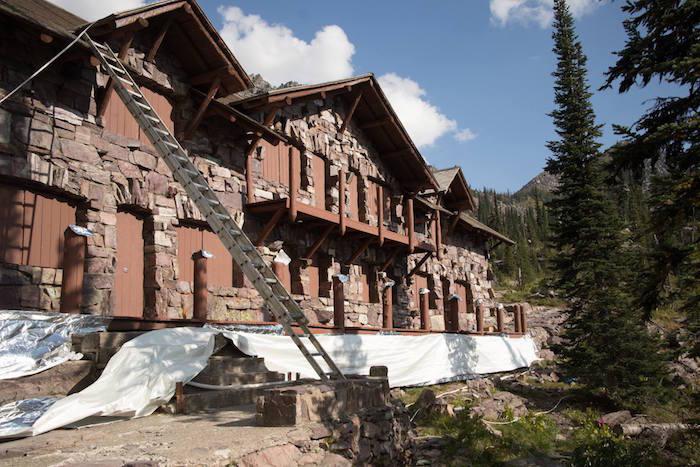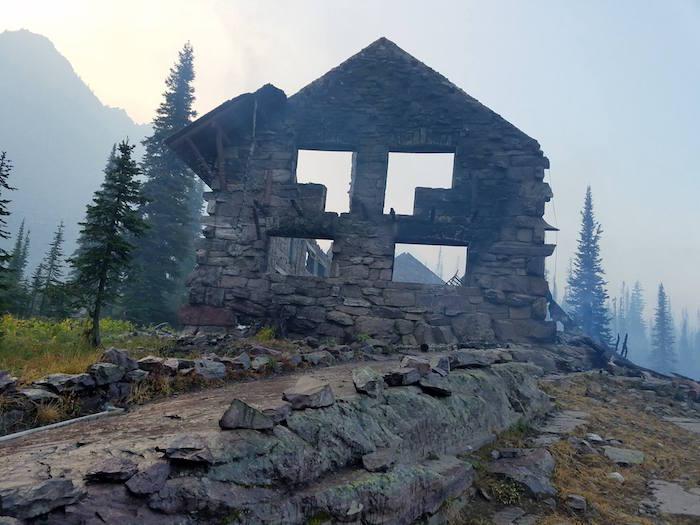In the end, all the firefighters could do was stand back and watch as flames consumed the historic Sperry Chalet, an icon of an earlier time when the Great Northern Railway brought visitors to northern Montana to explore the Rocky Mountains on horseback treks across the landscape that would become Glacier National Park.
Perched at 6,560 feet above sea level and near the lip of a glacial cirque, the chalet greeted thousands of visitors since it opened in 1913, and withstood heavy snows of winter and drenching summer rains. But it could not escape the Sprague Fire, which had been ignited by a lighting bolt on August 10. For days the fire mostly smoldered on the mountainsides above Lake McDonald, but as the days turned into weeks the fire took new life and became much more active.
Smoke from the fire and other blazes in the region became so troublesome that the Lake McDonald Lodge closed for the season a month earlier than planned, and the chalet itself shuttered on August 15 because of the proximity of the Sprague Fire. As the fire moved in the direction of the Sperry Chalet, efforts were mounted to protect the building that dates to 1913.
"Four helicopters supported the firefighters’ efforts with bucket drops on Sperry Chalet, as they had been doing in previous days," Glacier staff noted.
A highly skilled group of firefighters were assigned to defend the Chalet from the Sprague Fire using an extensive hose lay, sprinkler, and pump system. The hose lay and sprinkler system was tested daily. They also did fuel reduction around the five structures in the area. Protective wrap was applied in exposed wood areas and around the bottom of the buildings with decks as appropriate and safe. Given the remote area, size of the main building, and the stone construction, wrapping it in its entirety was not possible without mechanized equipment. A sprinkler system was installed and working on the Chalet’s roof.

Great efforts were taken to protect the Sperry Chalet from the approaching Sprague Fire/NPS
In the end, the fire proved too great for the firefighters, and it engulfed the building on August 31.

"At approximately 6:10 pm on August 31, the on-scene firefighters who had been battling the “ember shower” from the approaching fire suddenly noticed puffs of smoke under an eave. They immediately sprayed the area with water because they thought it was an ember on the roof. Almost instantaneously, the window broke out and flames were licking at the eaves." -- NPS


The Sperry and Granite Park chalets date to the days when Glacier was largely the domain of the Great Northern Railway. After bringing visitors to East Glacier aboard their trains, the railroad would send them out across the park on pack trips, with nights spents in a collection of nine "chalet camps." The chalets were located at St. Mary, Sun Point, Sperry, Granite Park, Cut Bank, Gunsight Lake, Two Medicine, Swiftcurrent Lake, and Belton.
The Sperry Chalet, which was built in 1913, offered 17 rooms that came with clean linens and three meals a day. The rusticness comes in the composting pit toilets outside and the cold water. It was reached via a 6.1-mile hike from the Lake McDonald Lodge that took hikers through Glacier Basin with its waterfalls flowing hundreds of feet down the cliff walls that surround the alpine meadow.
The chalet took its name from Lyman B. Sperry, a geologist and zoologist from a small college in Minnesota who was enticed to the park by a Great Northern passenger agent, according to View With A Room, Glacier's Historic Hotels and Chalets by Ray Djuff and Chris Morrison.
Sperry urged the railroad to construct a trail from Lake McDonald over Gunsight Pass to provide hikers a view of the Sperry Glacier, which the professor was credited with "discovering," the authors say.
In proposing a chalet colony near Sperry Glacier, Great Northern officials hoped to reap some of what they had sown a decade before in sponsoring construction of the Gunsight Pass trail. For the first two summers, 1911 and 1912, visitors to Sperry Glacier had to be content with a tent camp. Proof of th glacier's popularity as a destination was affirmed by the guest count: 461 people in 1912, second only to that of the Gunsight Lake camp.
During 1912, a small crew of Italian stone masons built a 22-by-80-foot stone kitchen and dining hall near the tent camp. Location dictated the choice of the building materials, and they made the most of ruble stone that was at hand. Loggers who specialized in timber framing harvested the humble fir and lodgepole pine native to the area for the building's rafters. Other building supplies were brought in by horses on long pack trains originating from Sun Camp. -- View With A Room, Glacier's Historic Hotels and Chalets

A potent late-season snowstorm, in June 2014, left the chalet looking like a winter wonderland/NPS






Comments
Super bummer.
Please restore the chalet. If they could build it then we should be able to restore it now.